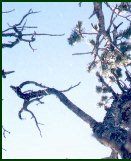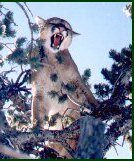



Cougar in British Columbia
The cougar, the largest wild cat native to Canada, is an imposing but evasive member of our wildlife. His secretive habits, and sometimes astounding predatory abilities --the cougar is capable of killing a 600-pound moose or elk-- have resulted in a wealth of human misconceptions and irrational fears.
Appearance
The adult cougar is a large animal: the heaviest on record weighed 276 pounds. Although there have been several cougar taken weighing between 190 and 210 pounds, the average adult male weighs about 150 pounds and the female 125 pounds. Large adult males may measure 9 feet in length, including a 30inch tail. The fur of the cougar is short and ranges in colour from reddish brown to a grey brown, with light underparts. Very young kittens are spotted with ringed tails. This coloration is gradually lost as young cougar reach adulthood. Adults are unmarked.
Distribution
The cougar is found only in the Western Hemisphere, from northern British Columbia to Patagonia in southern Argentina. In Canada, the cougar has been recorded from British Columbia east to New Brunswick. Due to human contact with the cougar over such an extensive geographical area, many local names have developed for this impressive animal: cougar, puma, mountain lion, red tiger, Indian devil, and Mexican lion are a few of their descriptive titles.
Territory
The home range of an individual cougar has been recognized for many years, but accurate limits have only recently been assigned to these ranges. Early estimates suggested that cougar maintained home ranges of up to 100 square miles. Females in the study area maintained territories of 5 to 20 square miles. Females with kittens required larger ranges than females without kittens and some overlap of female ranges was noticed. Males usually occupy larger territories: one male in the study occupied a range of 25 square miles.Transient cougars moved through occupied ranges but avoided residents.
Food Habits
The predatory activities of the cougar are legendary. Prey species range from large animals to mice and include deer, porcupine, beaver, hare, moose, elk, wild sheep, mountain goats, black bear (cubs), grouse, coyote, other cougar, domestic stock and household pets. The cougar is an opportunist when looking for food. A study of the winter food habits of cougar in south-central British Columbia concluded that mule deer was the staple winter food.
Breeding Habits
Cougar are polygamous, one male will breed with several females. Females reach sexual maturity at 2 to 3 years of age. Breeding takes place at any time of the year, and one to six kittens are born after a gestation period of about 3 months. The single observation of six kittens is an unusual record and observations in B.C. indicate one to four kittens are carried by the female. The female gives birth to her young in a rocky crevass or den, protected by roots or windfalls. Kittens are born with their eyes closed, but these open 10 to 14 days after birth.
Voice
Cougar produce a wide variety of sounds, the most striking of which is a piercing, drawn-out scream. Observations on captive cats indicate that only the females scream, and such behaviour is particularly prevalent during the mating period. Those who have been fortunate enough to hear this scream in the wild describe it variously as nerve-wracking, demonic, terror-striking and thrillingly impressive. Unfortunately, this distinctive cry is heard by very few outdoorsmen. Cougar also produce a distinctive chuckle, as well as many of the house-cat sounds (mews, hisses, spits, and growls) while kittens frequently emit a whistle-like sound used to attract the mother.
BOWHUNTING Canada ®
Canada (204) 762-6133
Back Contact Brochure FAQ References Booking E-mail